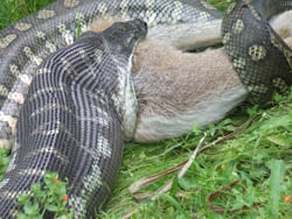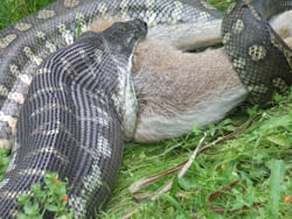Carpet pythons are fascinating creatures that can grow up to 13 feet long. As one of the most common snakes in Australia, they play a vital role in the ecosystem. But have you ever wondered what eats a carpet python?
Despite their size and strength, carpet pythons have predators that they need to watch out for. While they are skilled hunters themselves, they can fall prey to larger predators such as crocodiles and birds of prey. In this article, we will explore the different animals that pose a threat to carpet pythons and how they survive in the wild.
Carpet pythons are a popular prey for a variety of predators. Some of the animals that eat carpet pythons include birds of prey like eagles and hawks, other snakes, monitor lizards, and dingoes. Humans also pose a threat to carpet pythons through habitat destruction, hunting, and car strikes.

What Eats a Carpet Python?
Carpet pythons are one of the most popular and widely kept snakes in the world, known for their striking coloration and docile temperament. These snakes are native to Australia, New Guinea, and the surrounding islands, where they are found in a wide range of habitats, from tropical rainforests to arid deserts. While carpet pythons are generally considered to be apex predators, they are also preyed upon by a variety of other animals. In this article, we will explore the various predators of carpet pythons and their role in the ecosystem.
1. Dingoes
Dingoes are wild dogs that are native to Australia and are known to hunt a variety of prey, including kangaroos, wallabies, and rabbits. They are also known to prey on snakes, including carpet pythons. Dingoes are opportunistic hunters and will take advantage of any prey that they come across, including snakes that are basking in the sun or resting on the ground. While dingoes are not a major threat to adult carpet pythons, they can pose a significant risk to juvenile snakes.
Dingoes have a keen sense of smell and are able to detect the presence of snakes from a distance. They are also agile and can move quickly over rough terrain, making them effective hunters in the Australian bush.
2. Birds of Prey
Birds of prey, such as eagles, hawks, and owls, are also known to prey on carpet pythons. These birds have sharp talons and powerful beaks that allow them to grab and kill snakes with ease. While birds of prey are not a major threat to adult carpet pythons, they can pose a significant risk to juvenile snakes.
Birds of prey are able to detect the presence of snakes from a distance and will swoop down to grab them. They are also able to fly over rough terrain and can hunt snakes in areas that are inaccessible to other predators.
3. Monitor Lizards
Monitor lizards, also known as goannas, are large, carnivorous reptiles that are found throughout Australia. These lizards are known to prey on a variety of animals, including snakes, birds, and mammals. While monitor lizards are not a major threat to adult carpet pythons, they can pose a significant risk to juvenile snakes.
Monitor lizards are able to detect the presence of snakes from a distance and are able to climb trees and rocks to reach them. They have sharp claws and powerful jaws that allow them to grab and kill snakes with ease.
4. Other Snakes
Other snakes are also known to prey on carpet pythons. While this may seem surprising, it is not uncommon for snakes to eat other snakes. In fact, some species of snakes are exclusively snake-eaters. While other snakes are not a major threat to adult carpet pythons, they can pose a significant risk to juvenile snakes.
Other snakes are able to detect the presence of carpet pythons from a distance and are able to climb trees and rocks to reach them. They have sharp teeth and powerful jaws that allow them to grab and kill snakes with ease.
5. Cats
Domestic and feral cats are also known to prey on carpet pythons. While cats are not a major threat to adult carpet pythons, they can pose a significant risk to juvenile snakes.
Cats are able to detect the presence of snakes from a distance and are able to climb trees and rocks to reach them. They have sharp claws and teeth that allow them to grab and kill snakes with ease.
6. Humans
While humans are not natural predators of carpet pythons, they can pose a significant threat to these snakes. Humans have been known to kill carpet pythons for their skin or for sport. Habitat destruction and fragmentation also pose a significant threat to carpet pythons, as it can reduce the availability of prey and disrupt breeding and migration patterns.
7. Benefits of Carpet Pythons
Despite the various predators of carpet pythons, these snakes play an important role in the ecosystem. They are apex predators that help to control the populations of rodents and other small mammals, which can have significant impacts on the environment. Carpet pythons also help to maintain the balance of predator and prey populations in their habitats.
8. Carpet Pythons vs. Other Snakes
Carpet pythons are often compared to other species of snakes, such as ball pythons and corn snakes. While these snakes share some similarities, they have distinct differences in their behavior, habitat preferences, and care requirements.
Carpet pythons are larger and more robust than ball pythons and corn snakes, and are known for their striking coloration and docile temperament. They require larger enclosures and a more varied diet than these other species.
9. Carpet Pythons vs. Other Reptiles
Carpet pythons are also often compared to other species of reptiles, such as bearded dragons and leopard geckos. While these reptiles share some similarities, they have distinct differences in their behavior, habitat preferences, and care requirements.
Carpet pythons are carnivorous and require a diet of whole prey items, such as mice and rats. They also require a warm, humid environment to thrive, while bearded dragons and leopard geckos require a drier, cooler environment.
10. Conclusion
In conclusion, carpet pythons are apex predators that are preyed upon by a variety of other animals. While dingoes, birds of prey, monitor lizards, other snakes, cats, and humans pose a significant threat to these snakes, they play an important role in the ecosystem by controlling the populations of rodents and other small mammals. Carpet pythons also make fascinating and rewarding pets for those who are willing to provide them with the proper care and attention.
Frequently Asked Questions
Carpet pythons are a popular breed of snakes that are found in many parts of the world. These snakes are known for their impressive size and striking appearance. However, many people wonder about the predators that these snakes face in the wild. Here are some commonly asked questions about what eats a carpet python.
What animals are known to eat carpet pythons?
Carpet pythons are large snakes that are capable of defending themselves against most predators. However, there are a few animals that are known to prey on these snakes. Some of the most common predators of carpet pythons include birds of prey, such as eagles and hawks, as well as larger snakes like king cobras and anacondas.
In addition to these animals, carpet pythons may also face threats from other predators, such as wild dogs, feral cats, and even humans who hunt these snakes for their skin or meat.
Do carpet pythons have any defenses against predators?
While carpet pythons are generally well-equipped to defend themselves against predators, they do have a few defenses that they can use if necessary. For example, these snakes may use their powerful muscles to constrict around their prey, making it difficult for predators to escape.
In addition to this, carpet pythons may also use their camouflage to blend in with their surroundings, making it difficult for predators to spot them. Finally, these snakes may also release a foul-smelling musk in order to deter predators from attacking them.
Are carpet pythons endangered due to predation?
While predation is a natural part of the ecosystem, carpet pythons are not generally considered to be endangered due to these threats. In fact, these snakes are known for their adaptability and resilience, and are able to survive in a variety of different habitats despite the presence of predators.
However, it is worth noting that habitat loss and other human activities are posing a greater threat to carpet pythons than predation. As such, it is important to protect these snakes and their habitats in order to ensure their survival for future generations.
What should I do if I encounter a carpet python in the wild?
If you encounter a carpet python in the wild, it is important to remember that these snakes are generally not aggressive towards humans. However, it is still important to give them plenty of space and avoid disturbing them.
If you do need to move a carpet python, it is best to do so using a long stick or other tool, rather than using your hands. Additionally, it is important to remember that carpet pythons are protected in many areas, and it may be illegal to harm or kill them.
Can carpet pythons be kept as pets?
Carpet pythons are a popular choice for people who are interested in keeping snakes as pets. However, it is important to remember that these snakes can grow quite large, and require a significant amount of space and care in order to thrive.
If you are considering keeping a carpet python as a pet, it is important to do your research and make sure that you are prepared to provide for all of the snake’s needs. Additionally, it is important to purchase snakes from reputable breeders and to ensure that they have been raised in a healthy and humane environment.
Jungle Carpet Python Live Feeding! Full Hunt!!
In conclusion, the Carpet Python is a fascinating creature that is well adapted to its environment. While it may seem like a formidable predator, it is not invincible and has its own set of predators to contend with. It is important to remember that every creature plays a vital role in the ecosystem, and the Carpet Python is no exception.
From birds of prey to larger snakes, there are a variety of animals that will prey on the Carpet Python throughout its lifetime. However, this does not mean that the Carpet Python is helpless. It has a variety of defense mechanisms that it can use to protect itself from predators, including its impressive size and strength.
Overall, the Carpet Python is an important part of the food chain and plays an important role in maintaining the balance of its ecosystem. Whether it is being hunted by a predator or hunting its own prey, the Carpet Python is a fascinating creature that deserves our respect and admiration.


